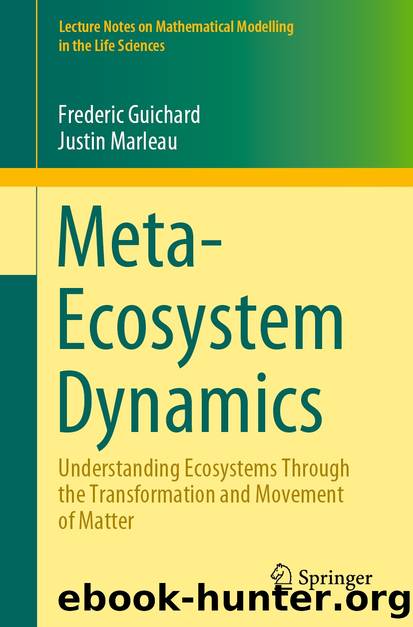Meta-Ecosystem Dynamics by Frederic Guichard & Justin Marleau

Author:Frederic Guichard & Justin Marleau
Language: eng
Format: epub
ISBN: 9783030834548
Publisher: Springer International Publishing
3.4.1.1 Spatial Synchrony in Meta-Ecosystems
There are numerous studies of spatial synchrony in metacommunities, but very few on nonlinear meta-ecosystems. The cycling and movement of (in)organic matter has been studied in linear meta-ecosystems displaying equilibrium dynamics, and recent studies have explored the specific role of nutrients for the maintenance of both local (within-ecosystem) and regional (among-ecosystem) fluctuations and spatial heterogeneity that can be captured by spatial synchrony. None of these studies have been conducted by reducing full models to phase dynamics under the strict assumption of weak coupling between local ecosystems. As a result, our understanding of nutrient and detritus movement as a driver of spatial (a)synchrony includes variations in both phase and amplitudes and is mostly based on numerical simulations. One important message conveyed by these studies is that nonlinear feedbacks introduced by nutrient and detritus dynamics can make spatial heterogeneity in meta-ecosystems very robust to in-phase and amplitude synchronization that would be expected as spatial fluxes are increased, thus violating assumptions of weakly-coupled oscillator theories.
For example, [115] showed that increasing the rate of nutrient movement in system Eq. 3.4 leads to both the loss of local stability of the local equilibrium (Fig. 3.3a) and to out-of-phase spatial synchrony of emerging oscillatory dynamics (Fig. 3.3b). Spatial in-phase synchrony of primary producers and consumers can be maintained under high nutrient diffusion rate, resulting in the doubling of frequency of in-phase nutrient oscillations with heterogeneous amplitudes (Fig. 3.4).
Most studies of spatial synchrony in meta-ecosystems were conducted with added levels of ecological complexity and will be covered into more details in Chap. 4. Here we simply discuss how feedbacks introduced by nutrient and detritus compartments can affect the spatial synchrony of phase and amplitudes.
Fig. 3.12The effects of meta-ecosystem network structure on local ecosystem dynamics after the local equilibrium solution is destabilized by high nutrient movement. The colours of the graphic insets indicate which time series is to be found in the local ecosystem, which means if two local ecosystems share the same colour, they have the same temporal dynamics. With equal to zero, the two meta-ecosystem configurations (a, b) show large oscillations in their most connected ecosystems, though the patterns differ greatly between them. With equal to 0.045, meta-ecosystems (c, d) continue to show oscillations, but the most centralized ecosystems no longer show the highest amplitude oscillations; however, the temporal and spatial dynamics differ greatly between them.
Adapted from [116]
Download
This site does not store any files on its server. We only index and link to content provided by other sites. Please contact the content providers to delete copyright contents if any and email us, we'll remove relevant links or contents immediately.
Sapiens: A Brief History of Humankind by Yuval Noah Harari(14312)
Sapiens by Yuval Noah Harari(5321)
Pale Blue Dot by Carl Sagan(4949)
Homo Deus: A Brief History of Tomorrow by Yuval Noah Harari(4870)
Livewired by David Eagleman(3728)
Origin Story: A Big History of Everything by David Christian(3665)
Brief Answers to the Big Questions by Stephen Hawking(3392)
Inferior by Angela Saini(3293)
Origin Story by David Christian(3169)
Signature in the Cell: DNA and the Evidence for Intelligent Design by Stephen C. Meyer(3097)
The Gene: An Intimate History by Siddhartha Mukherjee(3074)
The Evolution of Beauty by Richard O. Prum(2962)
Aliens by Jim Al-Khalili(2802)
How The Mind Works by Steven Pinker(2769)
A Short History of Nearly Everything by Bryson Bill(2659)
Sex at Dawn: The Prehistoric Origins of Modern Sexuality by Ryan Christopher(2500)
From Bacteria to Bach and Back by Daniel C. Dennett(2462)
Endless Forms Most Beautiful by Sean B. Carroll(2442)
Who We Are and How We Got Here by David Reich(2416)
